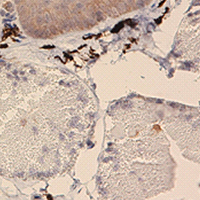Immunoreactivities of AR, ERα, ERβ and aromatase in the nuptial pad of Chinese brown frog (Rana dybowskii) during pre-hibernation and the breeding period

Submitted: 26 November 2020
Accepted: 25 March 2021
Published: 13 April 2021
Accepted: 25 March 2021
Abstract Views: 725
PDF: 485
HTML: 27
HTML: 27
Publisher's note
All claims expressed in this article are solely those of the authors and do not necessarily represent those of their affiliated organizations, or those of the publisher, the editors and the reviewers. Any product that may be evaluated in this article or claim that may be made by its manufacturer is not guaranteed or endorsed by the publisher.
All claims expressed in this article are solely those of the authors and do not necessarily represent those of their affiliated organizations, or those of the publisher, the editors and the reviewers. Any product that may be evaluated in this article or claim that may be made by its manufacturer is not guaranteed or endorsed by the publisher.
Similar Articles
- A Kittel, Zs Csapó, E Csizmadia, SW Jackson, SC Robson, Co-localization of P2Y1 receptor and NTPDase1/CD39 within caveolae in human placenta , European Journal of Histochemistry: Vol. 48 No. 3 (2004)
- Z Kalnina, K Silina, R Bruvere, N Gabruseva, A Stengrevics, S Barnikol-Watanabe, M Leja, A Line, Molecular characterisation and expression analysis of SEREX-defined antigen NUCB2 in gastric epithelium, gastritis and gastric cancer , European Journal of Histochemistry: Vol. 53 No. 1 (2009)
- D. Kluchova, A. Bolekova, C. Heichel, A. J. Bron, I. Kozak, NADPH-diaphorase expression in the Meibomian glands of rat palpebra in postnatal development , European Journal of Histochemistry: Vol. 54 No. 4 (2010)
- T. Nara, T. Yasui, O. Fujimori, W. Meyer, A. Tsukise, Histochemical properties of sialic acids and antimicrobial substances in canine anal glands , European Journal of Histochemistry: Vol. 55 No. 3 (2011)
- Daša Zupančič, Rok Romih, Immunohistochemistry as a paramount tool in research of normal urothelium, bladder cancer and bladder pain syndrome , European Journal of Histochemistry: Vol. 65 No. 2 (2021)
- Eetmad A. Arafat, Eman M.I. Youssef, Hanaa A. Khalaf, The possible alleviating effect of garlic supplement on the neural retina in a rat model of hypercholesterolemia: a histological and immunohistochemical study , European Journal of Histochemistry: Vol. 65 No. 4 (2021)
- Huiwen Li, Bo Huang, miR-19a targeting CLCA4 to regulate the proliferation, migration, and invasion of colorectal cancer cells , European Journal of Histochemistry: Vol. 66 No. 1 (2022)
- E Bronzetti, M Artico, I Kovacs, LM Felici, Expression of neurotransmitters and neurotrophins in neurogenic inflammation of the rat retina , European Journal of Histochemistry: Vol. 51 No. 4 (2007)
- V. Rizzatti, F. Boschi, M. Pedrotti, E. Zoico, A. Sbarbati, M. Zamboni, Lipid droplets characterization in adipocyte differentiated 3T3-L1 cells: size and optical density distribution , European Journal of Histochemistry: Vol. 57 No. 3 (2013)
- D. Cabibi, A.G. Giannone, C. Mascarella, C. Guarnotta, M. Castiglia, G. Pantuso, E. Fiorentino, Immunohistochemical/histochemical double staining method in the study of the columnar metaplasia of the oesophagus , European Journal of Histochemistry: Vol. 58 No. 1 (2014)
You may also start an advanced similarity search for this article.

 https://doi.org/10.4081/ejh.2021.3206
https://doi.org/10.4081/ejh.2021.3206










